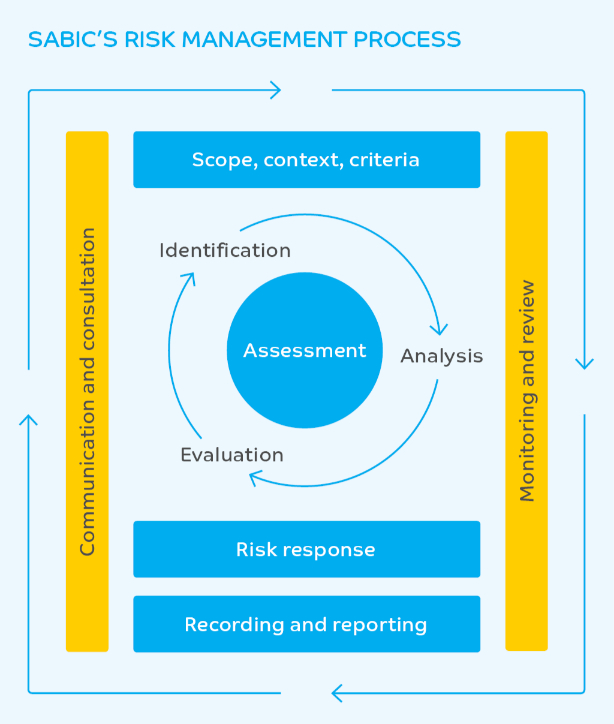Risks and Opportunities
Our risk management processes enable us to identify potential threats and capitalize on opportunities to achieve our strategic objectives.
ENTERPRISE RISK MANAGEMENT AND GOVERNANCE
Enterprise Risk Management (ERM) plays a crucial role in implementing an inclusive approach to risk management and business continuity. This includes identifying risks, collaborating with stakeholders across resilience phases to assess potential risks, and proactively mitigating them or reducing their impacts if they occur. Our focus is on securing the resilience of critical infrastructure to ensure continuity in providing essential products and services.
SABIC pursues its strategic objectives to maximize shareholder value by taking calculated risks within the organization's risk management framework. The ERM department provides leadership with early warnings of potential and emerging risks from internal or external events that could impact the company's strategic goals.
SABIC has a well-established risk management policy supported by an integrated governance system. Guided by international best practice standards, such as ISO and COSO, amongst others, SABIC's risk management process aims to effectively identify, understand, and manage threats to the company and its performance, while capitalizing on opportunities to advance strategic goals. This process also aids in establishing risk limits and controls and setting monitoring and reporting rhythms to enable business units and corporate functions to meet their objectives.

RISK CULTURE AND EXCELLENCE
In pursuit of its goals, SABIC upholds a zero-tolerance policy toward any actions compromising the safety and security of employees, contractors, the public, or the environment. SABIC also has zero tolerance for any actions that could lead to issues related to integrity, ethical and regulatory non-compliance, and breaches and/or infringement of intellectual property.
SABIC fosters a strong risk culture, viewing employees as custodians of this culture and entrusting them to uphold the company's standards and maintain risk mindfulness in executing SABIC's strategy. We continuously aim to enhance risk management awareness among employees, promoting their understanding and empowerment to identify and manage risks effectively.
SABIC ERM has executed several risk culture tools to enhance awareness within the company. Through training, standards, and procedures, SABIC ERM strives to create a disciplined and constructive control environment where employees understand their roles and responsibilities. Periodically, SABIC conducts surveys across its business units and corporate functions to assess risk management maturity and drive initiatives that advance risk maturity further. During 2024, SABIC continued its efforts to enhance its culture by:
- Providing refresher programs on risk management for the boards of operated and non-operated joint ventures (JVs).
- Launching the ERM Culture Capability Building (CCB) program to enhance risk management skills across the organization.
- Holding the third Manufacturing Day workshop to engage manufacturing leadership and SABIC affiliate presidents, sharing best practices.
- Conducting a “risk champion” program to improve ERM implementation and foster global knowledge sharing across SABIC.
- Publishing tools to support culture enhancement, including biannual ERM risk intelligence reports, videos, and newsletters.
- Supporting global entities and projects in Business Continuity Management (BCM) and developed Business Continuity Plans (BCPs) to boost resilience against major disruptions, such as IT outages.
- Achieving ISO 22301:2019 certification for SABIC's Business Continuity Management department.
- Collaborating with government and private sector entities to enhance ERM practices through expert advice and knowledge exchange.
2024 RISK LANDSCAPE
In 2024, petrochemical companies faced intensified supply chain and energy cost risks due to geopolitical uncertainties and a global economic slowdown. Challenges included disruptions to feedstock supply, surging shipping costs, and labor shortages. Rising energy prices and heightened competition for resources further strained production costs.
EMERGING RISKS
SABIC continues monitoring the impacts of changing external and internal environments to identify and assess emerging risks with development of response plans. Noteworthy issues of focus included the attacks in the Bab-el-Mandeb Strait, new regulations related to sustainability, and protectionist measures heightened by several elections taking place around the world in 2024. Additionally, recent advances in artificial intelligence have the potential to pose unfamiliar risks to our business and operations. In each case, effective assessment is carried out to ensure business continuity and resilience.
The impact of global and regional conflicts during 2024 on supply chains is evidenced by the constraints on energy and goods supply and the disruption of major transportation routes, raising prices across the board. SABIC has developed response plans to minimize these impacts, which include updating inventory, considering alternative shipping routes, and utilizing storage vessels.
RISK FACTORS
STRATEGIC RISKS
- Highly competitive industries
- Cyclical nature of the petrochemicals industry and market conditions
- Environmental challenges
- Rapidly evolving regulations relating to sustainability and ESG
- Digital transformation and artificial intelligence (AI)
OPERATIONAL RISKS
- Talent management
- Disruptions of supply chain services
- Geopolitical instability and pandemic
- Use of information technology
- Inherent process safety
- Projects under development
FINANCIAL RISKS
- Customer credit
- Foreign exchange
- Insurance policies
COMPLIANCE RISKS
- Intellectual property and technology licenses
- Disputes and/or litigation
- International trade controls
- Use and handling of materials and products
- Regional chemical regulations
Disclaimer: This abridged interactive version of the SABIC Integrated Annual Report 2024 is based on the original PDF report published on this website. In case of any discrepancy, the original PDF report will prevail.
